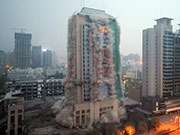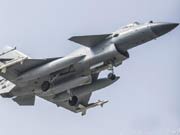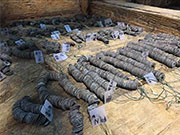


File photo: Steel plants in east China's Jiangsu province.
China's large and medium-sized steel companies lost 72 billion yuan ($11.22 billion) in the first 10 months of this year as they struggled with a collapse in steel prices. The average price of steel has plunged more than 30 percent this year due to many factors, including a drop in domestic demand stemming from China's economic slowdown. At the same time, steel makers have been reluctant to cut output in an attempt to cling to their market shares.
Liaoning-based Angang Steel Co made 923 million yuan in net profit in the first three quarters of 2014. In 2015, it lost 888 million yuan over the same period.
China's second largest steel maker Angang Steel said in its third-quarter report that it had tried to cut costs and improve efficiency to remain in the black, but could not overcome the plunge in steel prices this year.
Although steel prices have been falling for several straight years, China's major steel makers still managed to turn a profit - until this year.
The country's large and medium-sized steel companies, including Angang Steel, lost a combined 72 billion yuan in the first 10 months of this year, Beijing-based China Iron and Steel Association (CISA) said Monday in a statement posted on its website.
By comparison, the 101 steel companies tracked by CISA earned a net profit of 30.44 billion yuan in the same period in 2014, up 40.35 percent year-on-year.
The steel makers' losses resulted from the shrinking domestic demand due to an economic slowdown across much of the globe, as well as steel makers' reluctance to cut output, said Wang Guoqing, research director at the Beijing Lange Steel Information Research Center.
Price meltdown
In its financial report released on October 30, Angang Steel reported a net loss of 1.04 billion yuan in the third quarter, compared with a net profit of 346 million yuan over the same period in 2014.
The State-run steel marker pinned the losses on a decline in steel prices, though it also pointed out that the relative stability in prices of iron ore and coking coal, two raw materials of steel, didn't help its bottom line either, according to the report.
The average price of steel has fallen for five straight years. In 2011, it fell 7.8 percent from the previous year. It slumped 11.6 percent in 2012, 7.6 percent in 2013 and 16 percent in 2014, according to data from Beijing Lange Steel Information Research Center. So far this year, the price has plummeted 30.6 percent.
Over this period, China's steel makers have continued to boost output. They produced 881 million tons of steel in 2011, 951 million tons in 2012, 1.07 billion tons in 2013 and 1.13 billion in 2014.
But as the steel makers increased output year after year, the consumption has eventually started to fall. China's apparent crude steel consumption rose steady from 2011 to 2013, but fell 3.4 percent year-on-year in 2014 to 738.3 million tons, according to CISA' data.
Dearth of demand
The story of the collapse in steel prices has largely focused on the declining demand from China, the world's largest consumer of steel.
The Purchasing Managers Index (PMI) for China's steel industry slumped to 37 in November, a seven-year low, according to data released on December 1 by the China Federation of Logistics and Purchasing. November was the 19th straight month that the reading stood below 50, which indicates the industry was in contraction. Correspondingly, a reading above 50 indicates an expansion.
The drop in the index shows that China's steel industry continues to struggle, Wang told the Global Times on Monday.
It might be obvious, but steel is used for making things. When companies make fewer things, they don't need that much steel. With China in the middle of a global economic slowdown as it is shifting its economy away from manufacturing and investment, many industries have taken a hit, including the real estate, ship building, automobiles and home appliances, Wang said.
For instance, new constructions fell 13.9 percent year-on-year over the first 10 months of 2015, National Bureau of Statistics (NBS) said in November. Besides, investments in the real estate sector have also slowed.
And the demand picture doesn't look any brighter in 2016, according to Moody's Investors Service.
"Slowing real estate investment, modest infrastructure spending and lackluster manufacturing will reduce Chinese steel demand by about 5 percent in 2016," Zou Jiming, a Moody's vice president and senior analyst, said in a report in November.
Although the cost for raw material is declining, it won't be able to offset the decline in steel prices, Wang Bei, a researcher from mysteel.com, a Web portal providing steel information, told the Global Times on Sunday.
Reluctance to reduce output
In the face of declining demand, domestic steel makers have been making less steel, just not very much less.
China's crude steel output is projected to fall to 806 million tons in 2015, according to a report released by Shanghai-based news portal jiemian.com on Monday, citing data from China Metallurgical Industry Planning and Research Institute, a State-run consultancy focusing on the metallurgical industry.
There is evidence that steel makers are cutting output at a slightly faster pace.
In October, China's crude steel output fell 3.1 percent year-on-year, according to the latest data from NBS in November. However, from January to October, crude steel output only declined 2.2 percent year-on-year to 675.1 million tons.
Despite their financial losses, domestic steel makers have been reluctant to either cut output or reduce capacity. Most steel companies are owned by governments of localities, where they contribute much of the local GDP, said Wang Bei, the researcher from mysteel.com. Consequently, the local governments prefer to subsidize these companies rather than let them cut capacity at the cost of hurting the local economy.
Many State-owned steel companies also have a social obligation to employ workers, she said. If they suspend production or reduce capacity, it can cost people their jobs, hurting local employment rates.
Furthermore, steel companies don't want to risk market shares in case demand returns due to the country's more supportive policies for infrastructure constructions.
"They are afraid that they will lose market shares if they suspend or reduce production," she said.
Still, it's a risky strategy. If the demand doesn't return, maintaining output levels will only push prices down further, causing them to lose more money. It has the potential to turn into a vicious circle, said Wang. It's also not good for the industry's development
Some companies have realized the problem. On December 2, six major steel makers jointly announced they will cut the production of 200-series stainless steel by 30 percent starting in December, Xinhua reported on Sunday. These steel makers also suggested the government suspend the approval for any new production capacity.
Day|Week

 Spectacular aerial photos of the Three Gorges
Spectacular aerial photos of the Three Gorges New balls please! Polish sports stars strip off for risqué calendar
New balls please! Polish sports stars strip off for risqué calendar A glance at life of Ukrainian models working in Chongqing
A glance at life of Ukrainian models working in Chongqing Contestants of Mrs. Globe pose for photo in Shenzhen
Contestants of Mrs. Globe pose for photo in Shenzhen
 Bikini models attend hot pot banquet in Hefei
Bikini models attend hot pot banquet in Hefei 118-meter-high Never-used Building in NW. China Demolished
118-meter-high Never-used Building in NW. China Demolished J-10B fighters with homegrown engine in test flight
J-10B fighters with homegrown engine in test flight 10 tons of copper coins unearthed in 2,000 years old ancient tomb
10 tons of copper coins unearthed in 2,000 years old ancient tomb Beautiful graduate from police college becomes Internet hit
Beautiful graduate from police college becomes Internet hit Photos of U.S. Navy intruding in South China Sea released
Photos of U.S. Navy intruding in South China Sea released